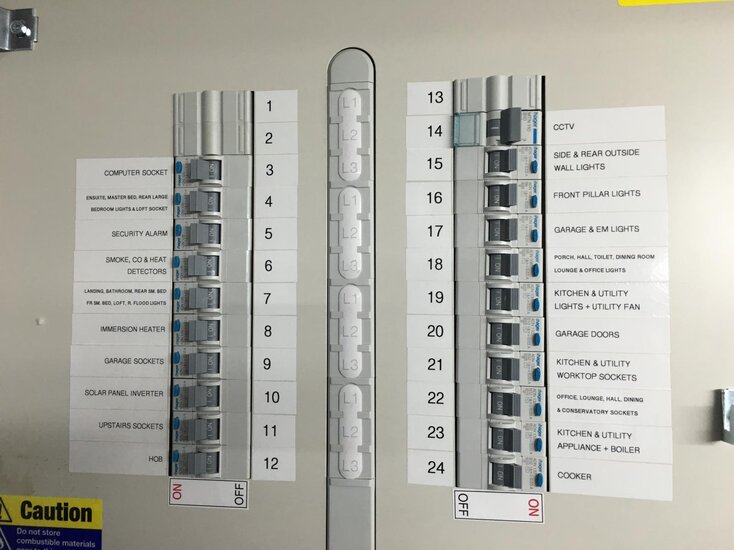U
uksparks
Hi,
I have not thought this through yet so don't give me stick yet.
I was just thinking of putting emergency lighting around the house as saw some really slick little LED things which are very discrete, anyway, it made me think, well why not just stick a UPS supply next to the consumer unit to feed a or many light circuits??
Like I say, I have not thought this through yet, but was thinking of using something like a 11 pole relay so you can switch live, neutral and earth.
So you would have a relay which is normally open and the mains grid supply would hold it closed, when the grid dropped out, it would switch to the UPS supply.
The grid would go from the consumer unit, via the RCBO, through the relay and out to the lights, the UPS supply, would be powered from one of the light circuits, the load side of the UPS which would be the offline supply for the lights so to speak, this would then go back into the enclosure via a 30mA RCD.then onto the relay to the light circuits.
Now the only thing would be, at present, lets take three light circuits for example, they are all standalone separate circuits with RCBO's, if i connected them to relays, maybe through in an MCB inline with each for good measure, im just thinking, they will all end up common back one on RCD unless i put at RCD or RCBO on each light circuit and didnt feed the UPS from one of the light circuits, but an MCB on its own.
I guess i would link out all the A1 - A2 terminals to pull each contactor on, so they are all piggy backed off each other so they all switch together.
Can anyone see any issues with this? The other thing i was thinking was what about if the grid was still on and the lights tripped say? would it be a problem running the lights off a UPS whilst the rest of the house is on the grid?
I appreciate UPS supplies are more designed for computers and the like, but I also don't see the problem in doing this.
The other thing i was thinking, would you switch the earth as well? or not? Not sure where the earth would come from if i did switch it to the UPS? Presumably its common with the Neutral?
What do you think? I know it sounds crazy.
I have not thought this through yet so don't give me stick yet.
I was just thinking of putting emergency lighting around the house as saw some really slick little LED things which are very discrete, anyway, it made me think, well why not just stick a UPS supply next to the consumer unit to feed a or many light circuits??
Like I say, I have not thought this through yet, but was thinking of using something like a 11 pole relay so you can switch live, neutral and earth.
So you would have a relay which is normally open and the mains grid supply would hold it closed, when the grid dropped out, it would switch to the UPS supply.
The grid would go from the consumer unit, via the RCBO, through the relay and out to the lights, the UPS supply, would be powered from one of the light circuits, the load side of the UPS which would be the offline supply for the lights so to speak, this would then go back into the enclosure via a 30mA RCD.then onto the relay to the light circuits.
Now the only thing would be, at present, lets take three light circuits for example, they are all standalone separate circuits with RCBO's, if i connected them to relays, maybe through in an MCB inline with each for good measure, im just thinking, they will all end up common back one on RCD unless i put at RCD or RCBO on each light circuit and didnt feed the UPS from one of the light circuits, but an MCB on its own.
I guess i would link out all the A1 - A2 terminals to pull each contactor on, so they are all piggy backed off each other so they all switch together.
Can anyone see any issues with this? The other thing i was thinking was what about if the grid was still on and the lights tripped say? would it be a problem running the lights off a UPS whilst the rest of the house is on the grid?
I appreciate UPS supplies are more designed for computers and the like, but I also don't see the problem in doing this.
The other thing i was thinking, would you switch the earth as well? or not? Not sure where the earth would come from if i did switch it to the UPS? Presumably its common with the Neutral?
What do you think? I know it sounds crazy.



 ) that white paper you are welcome to it, the actual regs may have changed slightly but the physics and actual electrical principles have stayed the same.
) that white paper you are welcome to it, the actual regs may have changed slightly but the physics and actual electrical principles have stayed the same.





